Fodsports FX 60C vs FX30C Pro: What's new techs are the FX 60C bringing to us? Fodsports is a brand worth-mention for helmet communication and video recording. This brand has established itself as a key player with its innovative Bluetooth camera intercom systems. Recently, Fodsports has released a new camera intercom, the FX 60C. How […]
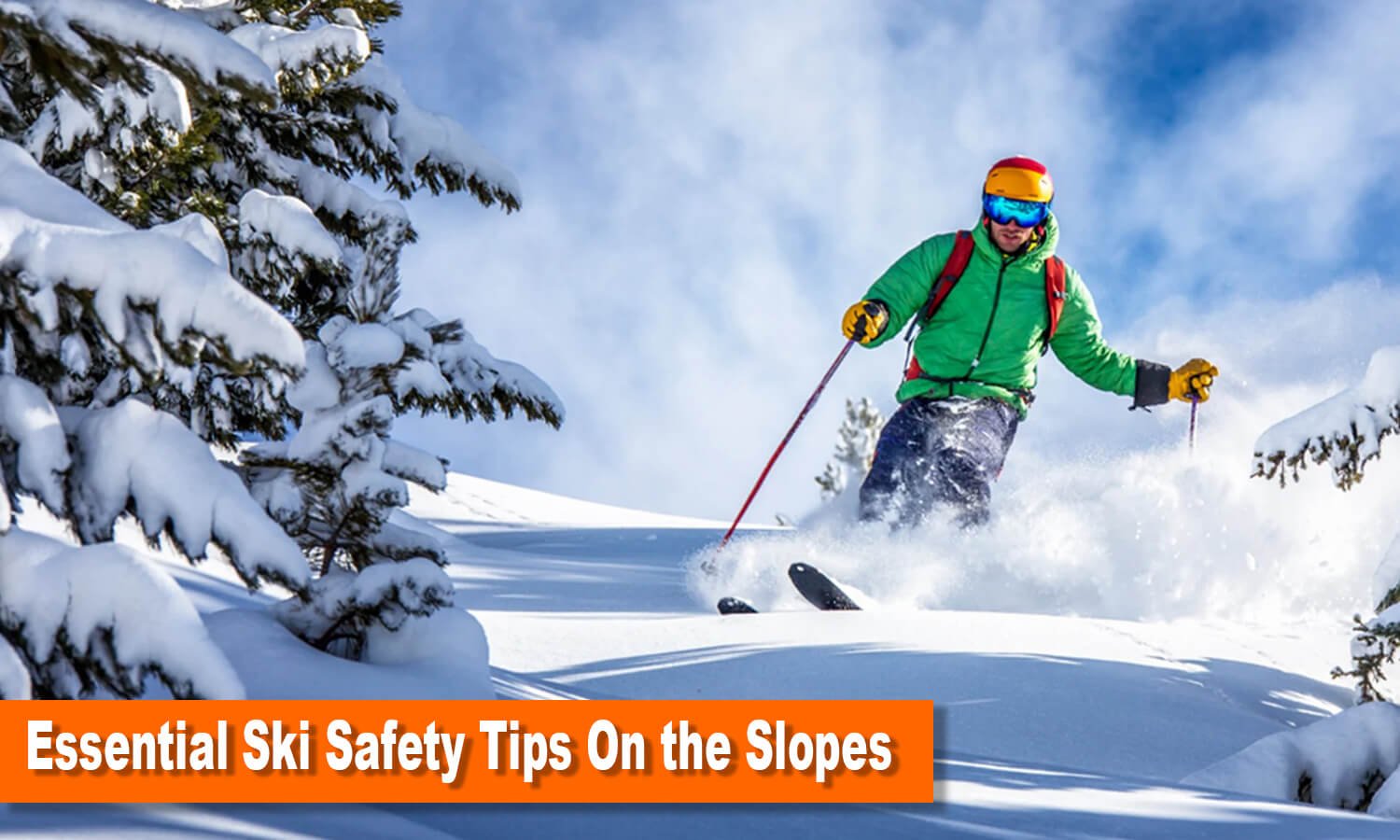
15 Essential Ski Safety Tips On the Slopes
Skiing is an exhilarating winter sport that combines adventure, speed, and breathtaking scenery.
Whether you're a seasoned skier or a beginner, safety should always be your top priority.
The ski slopes can be unpredictable, especially when you firstly come to an new slope. Without proper precautions, a fun day on the mountain can quickly take a dangerous turn.
In this ultimate guide, we’ll walk you through essential ski safety tips and strategies to stay safe while enjoying your time on the slopes.
Table of Contents
Ski Safety Tips 2025
1. Prepare Before You Hit the Slopes
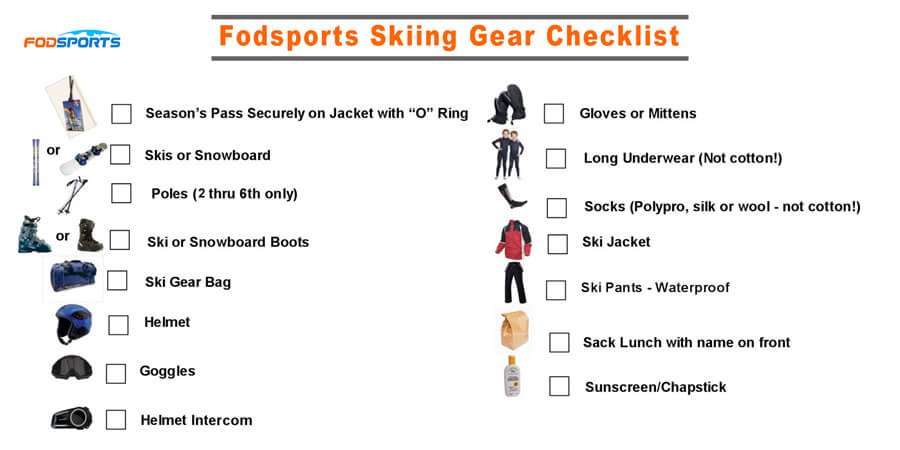
skiing gear checklist
Preparation is key to ensuring a safe and enjoyable skiing experience. Here are some steps to take before you even put on your skis:
a) Get the Right Gear
- Helmet: Always wear a properly fitted ski helmet. It can significantly reduce the risk of head injuries in case of a fall or collision.
- Ski Goggles: Protect your eyes from wind, snow, and harmful UV rays. Goggles also help you see clearly in changing light conditions.
- Layered Clothing: Wear moisture-wicking base layers, an insulating mid-layer, and a waterproof outer layer. These cloths will help you stay warm and dry.
- Ski Boots and Bindings: Ensure your boots are comfortable, and your bindings are adjusted to your skill level and weight by a professional.
- Gloves or Mittens: Keep your hands warm and protected from frostbite.
- Helmet Communication System: If ride with a friend or a group, use ski intercoms to make sure you can communicate with them.
b) Check Your Equipment
Inspect your skis, snowboard, or other equipment before you start. Look for cracks, loose bindings, or worn edges.
Renting skiing equipments from the ski slope? Then check them and make sure the gear is properly fitted and in good condition.
c) Know the Weather Conditions
Check the weather forecast for the day. Poor visibility, strong winds, or heavy snowfall can make skiing more challenging and hazardous. Avoid skiing in extreme conditions.
2. Warm Up and Stretch
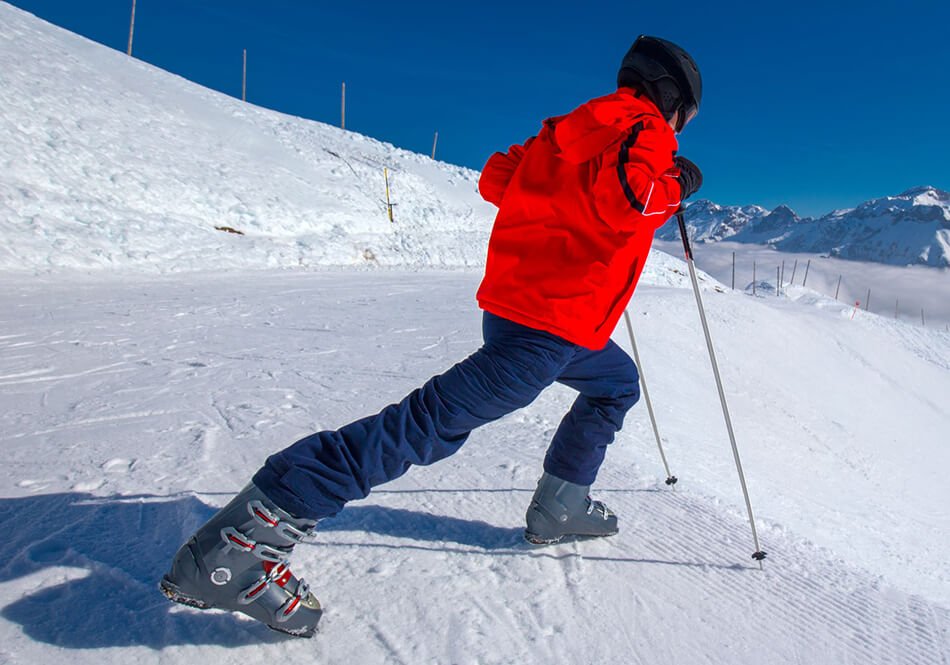
Do some skiing warm up and stretches before starting skiing - ski safety tips
Cold muscles are more prone to injuries while you are doing sports activities. Before you start skiing, take 10–15 minutes to warm up by walking briskly or doing light exercises. Stretch your legs, arms, and back to improve flexibility and reduce the risk of strains or sprains.
3. Take a Lesson If You’re a Beginner
If you’re new to skiing, don’t skip professional lessons. Ski instructors can teach you proper techniques, help you understand the basics of balance and control, and show you how to stop safely. Learning how to fall correctly can also reduce the chance of injuries.
4. Follow the Skier’s Responsibility Code

Follow this skiing responsibility code while you are on the slope
Most ski resorts follow the Skier’s Responsibility Code, which outlines the rules for safe skiing. Here are the key points:
- Stay in Control: Always ski within your skill level and speed. Being out of control can endanger both you and others.
- Yield to Others: Skiers or snowboarders downhill (ahead of you) have the right of way. Avoid cutting them off.
- Look Uphill When Merging: Check for oncoming skiers before entering a trail or starting after a stop.
- Obey Signs and Markers: Pay attention to trail signs, warnings, and closures. Skiing on closed trails is not only dangerous but may also lead to penalties.
- Avoid Stopping in Blind Spots: Don’t stop in the middle of a trail or on a slope where you aren’t visible to others.
5. Know Your Limits
It’s true that tempting to push yourself on the slopes. But skiing beyond your ability level can lead to accidents.
You should learn about different ski slope ratings, especially for beginners.
And, always stick to trails that match your skill set:
- Green Runs: Easy slopes for beginners.
- Blue Runs: Intermediate trails with moderate difficulty.
- Black Runs: Advanced trails for experienced skiers.
If you’re tired, take a break. Fatigue can impair your judgment and reaction time, increasing the risk of falls.
6. Stay Hydrated and Fueled
Cold weather can mask dehydration, so it’s important to drink water throughout the day. Remember the following tips:
- Bring a small water bottle or hydration pack with you.
- Eating snacks or meals rich in carbohydrates and protein will keep your energy levels high.
- Avoid alcohol while skiing—it can impair your balance, coordination, and decision-making.
7. Learn How to Fall Safely

Fall safely on the slope
Falling is part of skiing, especially when you’re learning or trying new techniques.
Here’s how to minimize injury when you fall:
- Relax Your Body: Resist the urge to tense up. Relaxing your body can reduce the impact of the fall.
- Avoid Using Your Hands to Break the Fall: Instead, try to land on your side or back. Using your hands can lead to wrist or arm injuries.
- Keep Your Legs Together: This helps prevent twisting or straining your knees.
After falling, assess your condition before getting up. If you’re hurt, signal for help.
8. Stay Aware of Avalanche Risks
If you’re skiing in backcountry areas, avalanches are a real danger. Follow these safety precautions:
- Take an Avalanche Safety Course: Learn how to recognize avalanche-prone areas and how to respond if one occurs.
- Carry Safety Gear: Always carry an avalanche beacon, probe, and shovel. Know how to use them.
- Check Avalanche Reports: Look up local avalanche forecasts before heading out.
- Ski with a Buddy: Never ski alone in the backcountry.
9. Ski with a Group or Buddy
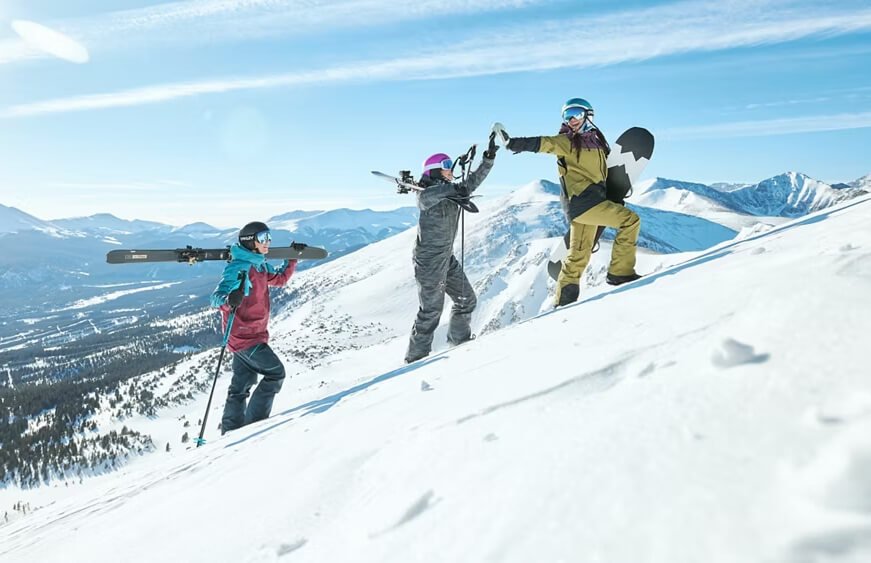
Ski with a group - skiing safety tips
Skiing alone can be dangerous, especially in remote areas. Always ski with a group or at least one buddy.
Besides, bringing a ski helmet communication system with you will be a better option. You can keep in contact with your partners while you are on the slope.
If anything happens on the slope, use the communication system to inform each other.
If you get separated and are not equipped with communication systems, agree on a meeting point beforehand. Make sure someone in your group knows your plans, especially if you’re venturing off-piste.
Prepare Ski Intercom for Group Communication on the Ski Slopes
10. Be Mindful of Fatigue
Skiing is a physically demanding activity, and exhaustion can sneak up on you.
Fatigue affects your reflexes and decision-making, increasing the risk of accidents.
Listen to your body and take breaks when you need them. And, end your day before you’re too tired to ski safely.
11. Watch Out for Other Skiers and Snowboarders
Crowded slopes can be tricky to navigate. So please be aware of your surroundings and maintain a safe distance from others.
Besides, you should avoid sudden stops or unpredictable movements, as they can lead to collisions.
12. Respect Nature and the Environment
Ski slopes are part of the natural environment, and it’s important to respect them.
Skiers should avoid littering, stick to designated trails, and stay away from wildlife.
What's more, if you’re skiing in backcountry areas, leave no trace behind.
13. Know What to Do in Case of an Emergency
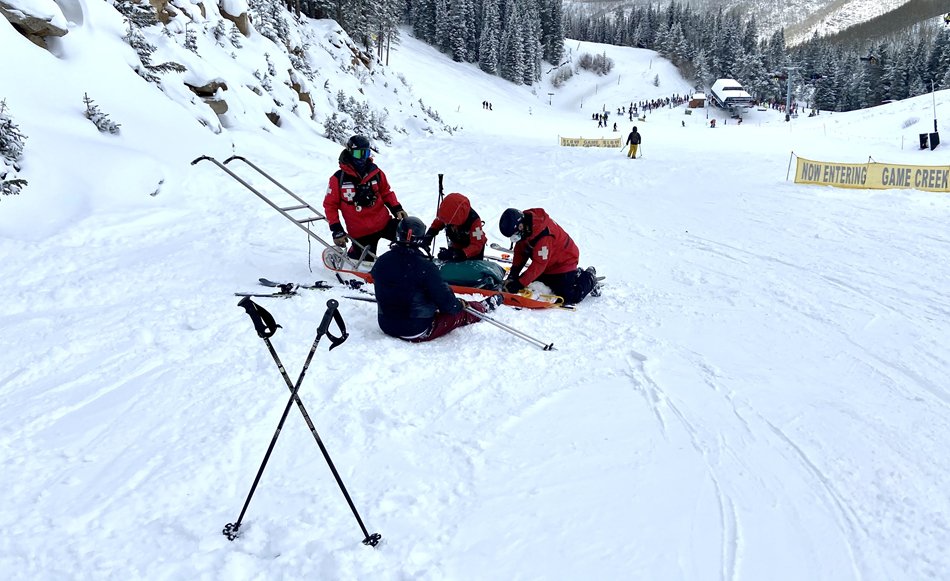
Skiers make an "X" signal for help when there is a ski emergency
Despite your best efforts, accidents can happen on the slope sometimes. Here’s what to do if you or someone else gets injured:
- Stay Calm: Assess the situation and avoid panicking.
- Signal for Help: Use your ski poles to form an "X" in the snow or wave to get attention.
- Move Safely: If possible, move to the side of the trail to avoid further danger. Don’t move someone who may have a serious injury, such as a broken bone.
- Carry a Phone or Ski Intercom: Make sure you have a way to contact ski patrol or emergency services.
14. Protect Your Skin from the Sun
It’s easy to forget about sun exposure when you’re surrounded by snow, but UV rays are stronger at higher altitudes.
Besides, snow also reflects sunlight, increasing your risk of sunburn.
Skiers can apply a broad-spectrum sunscreen with an SPF of at least 30 to your face and exposed skin. Reapply every few hours, especially if you’re sweating.
15. Stay Alert on Chairlifts
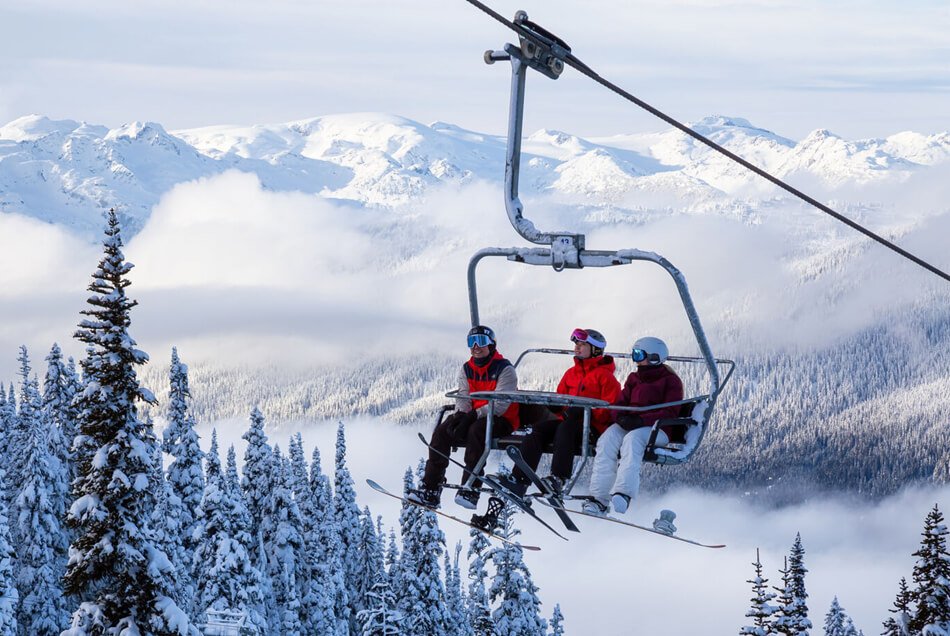
Stay safe when you are on the chairlifts
Chairlifts are an integral part of skiing, but they also come with risks. Follow these tips to stay safe when you are on the chairlifts:
- Sit Back and Hold On: Keep your back against the seat and hold onto the safety bar (if available).
- Don’t Jump Off: Only get off the lift at the designated area.
- Be Careful with Loose Gear: Make sure your skis, poles, or backpack straps don’t get caught on the lift.
Frequently Asked Questions
What is the first rule of skiing?
The first rule of skiing is to stay in control at all times. This means you should always be able to stop or change direction to avoid people, obstacles, or hazards on the slope.
What's more, you should ski at a speed that matches your skill level and the conditions around you. And, staying in control helps prevent accidents and ensures your safety as well as the safety of others.
Besides, always be aware of your surroundings and follow the rules of the ski resort or area.
Is skiing dangerous for beginners?
Skiing can be risky for beginners, but it’s not too dangerous if you take the right steps.
Most accidents happen when people try to ski beyond their skill level. Beginners should start on slopes with easier ski slope ratings. And, take lessons from a trained instructor, and wear proper safety gear like a helmet. Besides, staying in control and following the rules on the slopes will reduce risks.
While falls are common when learning, they’re usually minor. With practice and caution, skiing can be a safe and fun activity.
How dangerous is skiing compared to other sports?
Skiing is generally not as dangerous as some high-risk sports like football, rugby, or mountain climbing, but it has its risks.
Most skiing injuries are minor, like bruises or sprains, and happen due to falls or loss of control.
Serious injuries, like broken bones or head injuries, are rare to happen on the slope. But it can still occur, especially if skiers go too fast or don't follow safety rules.
Compared to sports like cycling or running, skiing has a slightly higher risk because of speed, weather, and terrain.
But, with proper training, equipment, and caution, skiing can be as safe as many other recreational sports.
Conclusion
Skiing can be one of the most thrilling and rewarding outdoor activities in the world. But skiing safety should never be overlooked.
Preparing properly, staying aware of your surroundings, and knowing your limits are important.
The above mentioned ski safety tips can minimize risks and maximize your enjoyment on the slopes.
Remember, the mountains are meant to be fun, and staying safe ensures you can keep coming back for more adventures.
Related Reading:
26 Best & Most Unique Gifts For Skiers
Top 18 Skiing Essentials: The Most Comprehensive Checklist

Motorcycle mechanic, writer. Interested in motorcycle gear for years. Like to stay up to date with the newest products and techniques of the motorcycle.
The Fodsports FX 60C is leading a revolution in the Bluetooth camera intercoms market. This 2025 newest intercom with camera by Fodsports is designed to enhance your riding experience. This device comes with advanced features like Bluetooth 5.4, 4K HD recording, 10-way intercom, and plenty more. So it is clear that this device seamlessly blends […]
For motorcycle riding safety, effective stopping rocks because it has an influence on how fast you stop how stable you are, and how much control you get. Figuring out when and how to use the front and back brakes can really bump up your riding game and keep you safe. This guide is gonna show […]
As the electric vehicle Revolution accelerates the world of motorcycles, is no exception To be a landmark year for electric motorcycles with Cutting Edge. Technology, performance, and design advancements reshape the market. Electric motorcycles. Now, offers impressive, power, extended range, and Sleek designs. Whatever you need, the options in 2025 are more diverse and exciting […]
Motorcycle enthusiasts are a dedicated group. They enjoy the sense of liberation on the open highway, the excitement of riding, and the opportunity to display their beloved two-wheeled machines. But in today’s world, there’s a new debate revving up in the motorcycle community: gas vs. electric motorcycles. If you're an experienced rider or a beginner […]
Shopping for a motorcycle enthusiast can be tricky, especially if you’re not familiar with the gear and gadgets that make riding more enjoyable. Whether it’s the thrill of the ride, the joy of the open road, or the love for motorcycles themselves, finding the perfect Christmas gift can feel overwhelming. Here is a guide of […]

